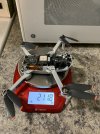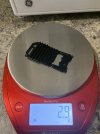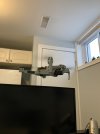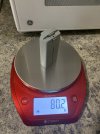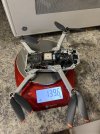To get lighter version - I took off top cover, bottom cover and heat sink. This is all on stock battery. Checked temperature without heat sink and it was barely lukewarm, so no issues at all indoors. Then I did some testing today: stock Mini 2 (238g) vs lighter Mini 2 (212g) hovering above floor indoors. Lighter version did hover for 4 minutes more. So 26g difference (11% weight difference) gives about 4 minutes extra air time.
Took a test flight outside with lighter version and some observations so far:
1. Even less noisy than stock, noticeably less noisy. Pitch is lower and you can hear it it's not struggling at all vs stock one. I had hard time even hearing it from 6ft away outside when it was hovering. This thing is seriously stealthy.
2. Flight time increased and you can tell the difference right away looking at timer and percentage and slower voltage drop.
3. Biggest surprise was to NOT get any strong wind warning even when I went 400ft altitude. Previously flying in the same spot multiple times I ALWAYS got strong wind warning starting at 240ft altitude. I'm guessing 11% weight reduction makes that much easier for motors to correct for wind. Contrary to popular belief that heavier drones handle wind better. I'm assuming it's not about weight but about weight to power ratio and how easy it is for drone to compensate for wind.
4. I was worried if it will start snowing during the flight and ruining the drone, but it came back dry as a bone. So that's something to look out for. I might cover it with transparent plastic wrap on top - will barely weigh anything, but will cover it from rain/snow. That might be the solution.
5. It's hard to explain, but I felt that drone was more agile and easy to control in windy weather.
Things I want to check tomorrow: max speed to find out if it'll increase due to less weight of drone or if its limited by firmware and will stay the same as stock. Overall I'm very pleased with results so far.
Took a test flight outside with lighter version and some observations so far:
1. Even less noisy than stock, noticeably less noisy. Pitch is lower and you can hear it it's not struggling at all vs stock one. I had hard time even hearing it from 6ft away outside when it was hovering. This thing is seriously stealthy.
2. Flight time increased and you can tell the difference right away looking at timer and percentage and slower voltage drop.
3. Biggest surprise was to NOT get any strong wind warning even when I went 400ft altitude. Previously flying in the same spot multiple times I ALWAYS got strong wind warning starting at 240ft altitude. I'm guessing 11% weight reduction makes that much easier for motors to correct for wind. Contrary to popular belief that heavier drones handle wind better. I'm assuming it's not about weight but about weight to power ratio and how easy it is for drone to compensate for wind.
4. I was worried if it will start snowing during the flight and ruining the drone, but it came back dry as a bone. So that's something to look out for. I might cover it with transparent plastic wrap on top - will barely weigh anything, but will cover it from rain/snow. That might be the solution.
5. It's hard to explain, but I felt that drone was more agile and easy to control in windy weather.
Things I want to check tomorrow: max speed to find out if it'll increase due to less weight of drone or if its limited by firmware and will stay the same as stock. Overall I'm very pleased with results so far.
Last edited:



